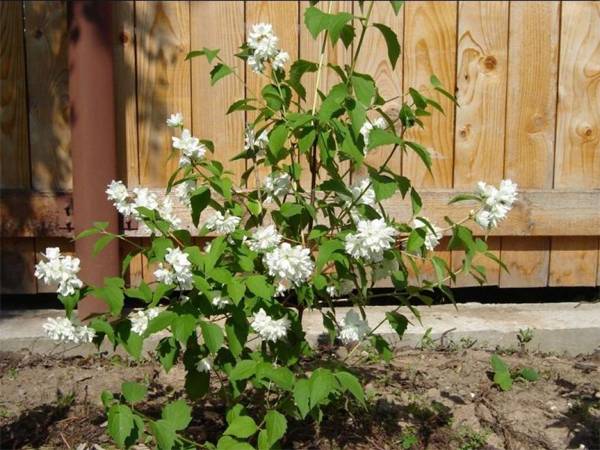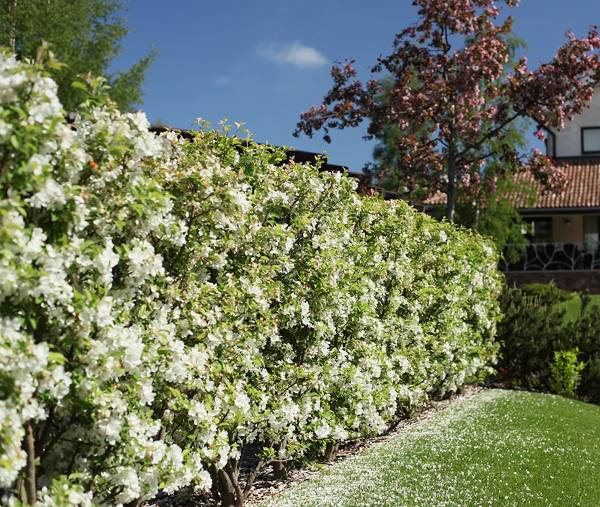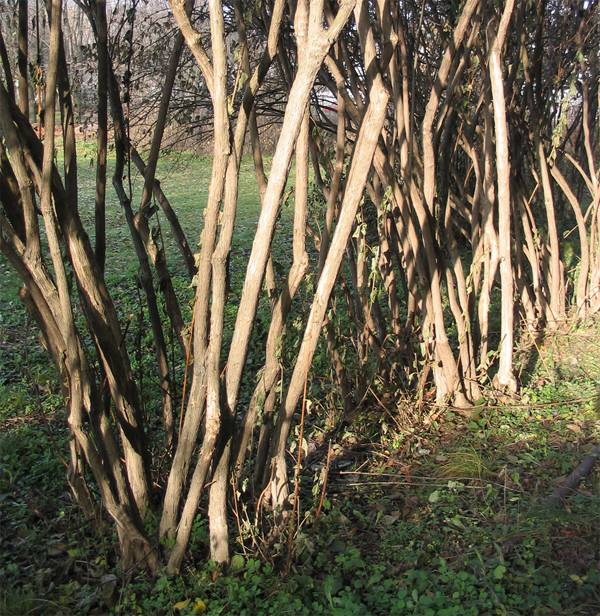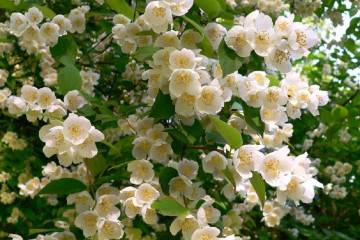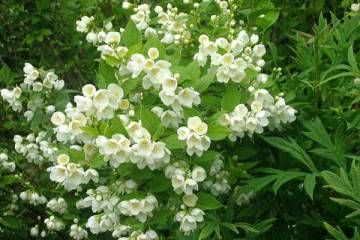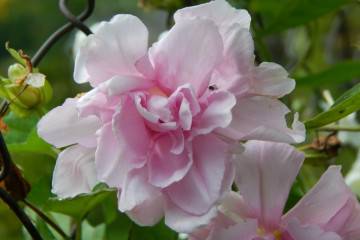Chubushnik Virginal - description, planting and care
Content:
Chubushnik Virginal (Philadelphus Virginal) is a picturesque deciduous plant. Belongs to the Hortensiev family. Strong, undemanding shrub to environmental conditions. It grows well even in areas with a highly gassed atmosphere, making it popular with urban plant breeders. It is also known as a girl's mock-mushroom.
Description of mock-mushroom Virginal
Chubushnik virginsky belongs to the oldest terry varieties of the plant, which received its Russian-language name from the first creators of mouthpieces and shafts for smoking pipes. With proper care, this lush and massive shrub can grow up to 2 m.The crown width of an adult shrub is 3 m.
The flowering period of the chubushnik begins from the first days of June and lasts from two weeks to two months. It blooms with white or cream flowers, exuding a pleasant aroma. The length of the inflorescences is 10 cm or more. The flowers are large, mostly of a creamy shade, the maximum size is 5 cm in diameter.
Like all Hortensiaceae, the chubushnik is a deciduous shrub. Its leaves are smooth to the touch, their maximum length is 5–6 cm. In the autumn season, they fall off, turning yellow.
Today there are many varieties of chubushnik. They can be distinguished from each other by their smell during the flowering of flowers, the time of flowering and the shape of the flowers. Virginal is often confused with his closest "relatives" - Virginal's mock-mop (Philadelphus coronarius Virginal), Philadelphus coronarius Schneesturm's mock-mop (Philadelphus coronarius Schneesturm) and Lemoinei Virginal's mock-mock. All shrubs bloom profusely with large flowers.
Virginal is cold-resistant, can withstand temperatures down to -25 ° C. But this does not mean that the chubushnik does not need a winter shelter. Shrubs growing in the central and northern regions are especially in need of protection. The tips of young shoots cannot withstand the harsh winter and freeze over.
Possessing resistance to infectious diseases, the chubushnik is afraid of garden pests.
Planting a plant
With planting seedlings and subsequent care for them, gardeners, as a rule, do not have any difficulties. The shrub is quite hardy and unpretentious, it takes root well in any type of soil. An exception to the rule is soil with high acidity.
Chubushnik Virginal prefers lighted areas, but can grow in partially shaded areas.
Another factor contributing to the development of a plant is the level of groundwater. The lower it is, the better the bush will develop.
Planting from seeds
Virginal does not reproduce with seeds due to the laboriousness of the method. In addition, shrubs grown from seeds mutate, losing the qualities characteristic of this variety.
Landing in open ground
Planting a seedling with an open rhizome is planned for the spring-autumn period. For those grown in containers (in a coma of earth), the planting time is not limited, however, the spring months are considered the best period for Central Russia and northern Russia. By planting a shrub at the very beginning of spring, the gardener will give the plant the opportunity to properly root and get stronger before the onset of the first frost.
The size of the planting hole depends on the size of the plant rhizome. Traditionally, the depth of the fossa is 50 cm, and the diameter is 50-60 cm.
The planting process consists of the following steps:
- The bottom of the hole is filled with drainage material: expanded clay, pebbles, broken brick, crockery shards or small stones. Before placing the drain on the bottom of the hole, it is mixed with sand taken from the bottom of the river. Drainage height 10-15 cm.
- Separately, a nutrient mixture is prepared from garden soil, sand and rotted grass, taken in a ratio of 3: 1: 1. Diluting the mass with a small amount of nitrophosphate, the resulting mixture is covered with a drainage layer.
- A seedling is immersed in the planting hole and the rhizome is sprinkled with earth.
- The plant is watered with plenty of water, then the soil is tamped and mulched with a 5-centimeters layer of dry foliage, sawdust, peat or compost.
When planting several chubushnik bushes at once, make sure that there is at least 2 m between the two bushes. Many gardeners use shrubs as a hedge. In this case, the distance between seedlings can be reduced to 1–1.5 m.
How to care for a mock-mushroom Virginal
Chubushnik care is carried out according to generally accepted rules. In order for the bush to develop quickly, it must be watered in time, fed 2-3 times a season and covered for the winter.
Weeding is done as the weeds grow. If a small accumulation of weeds has formed around the chubushnik, this will not harm it.
Watering
Variety Virginal prefers slightly moist soil, so irrigation should be carried out regularly using settled water, well warmed up by the sun's rays. Watering with cold water is unacceptable. 1-2 buckets of water are poured under each bush. It is important to try not to flood the plant and prevent moisture stagnation.
Watering is carried out at intervals of 2 times a week, provided that on the hottest days the air temperature does not warm up to the maximum mark. In dry years, the frequency of watering is increased - watering the mock-orange every other day. In the rainy season, the procedure is reduced to 1 time per week or watering is stopped altogether. During the flowering period, the chubushnik regularly needs moisture.
Systematic loosening of the soil around the plant enhances air exchange. It is especially important to loosen the soil after heavy rain, when the surface layers of the earth are compacted and turn into a crust.
Top dressing
Virginal begins to feed the mock-orange from the second year of life. A young plant is not fed, since the substances that make up the fertilizers can burn the root system of an immature seedling.
Gardeners who have resorted to mulching the trunk circle in early spring can refrain from feeding during the spring. During the period of bud formation, all plants are necessarily fed with mineral fertilizers.For autumn feeding, organic or phosphorus-potassium fertilizers are used.
Pruning
If the chubushnik is not cut off at the beginning and at the end of the season, over time the bush loses its attractiveness and decorative effect. Spring pruning begins immediately after the bush is freed from the winter shelter. All dead and broken twigs and overgrowths that have accidentally escaped from under the shelter are subject to removal.
In the fall, pruning of the mock-orange begins after the end of the flowering period. First of all, dried inflorescences are removed, after which the crown is thinned out, so it will be easier for the plant to develop in spring.
Reproduction methods
Traditionally, gardeners propagate the Virginal mock-orange in three ways:
- add layering;
- dividing the bush;
- cuttings.
The easiest way to reproduce is by layering. In the spring, a healthy shoot is bent to the ground and instilled in, having previously fixed it with staples or other improvised tools. With the arrival of autumn, the rooted shoot is separated from the parent bush and transplanted to another place.
Diseases and pests
According to gardeners, the plant is very rarely sick, so it does not need seasonal preventive treatment. A much greater danger for the chubushnik is the raids of insect pests:
- bean aphid;
- spider mite;
- green leaf weevil.
To scare off the listed pests, specially developed insecticide substances are used, although some gardeners prefer to use folk methods.
You can scare away insects with decoctions and infusions made from wormwood, tansy, dandelion, marigolds, yarrow, potato and tomato tops. Many gardeners talk about the effectiveness of tobacco dust infusion.
Preparing for winter
Both young and old bushes growing in the northern regions and the Middle Lane are subject to mandatory shelter for the winter. Gardeners who grow chubushnik in the southern regions do not insulate the plant.
First of all, the trunk circle is mulched using peat or other similar material for this purpose. Then the branches are tied up and the whole bush is wrapped with agrofibre. When snow appears, it is scooped up to the covered plants so as to build an additional barrier that protects the bushes from cold and wind.
After the actual onset of spring, Virginal mock-orange is immediately freed from the covering material. Remaining covered in warm weather, the bush will rot.
Use in landscape design
Homeowners and landscape designers love the Virginia mock-orange for its unpretentiousness, durability, decorativeness and fragrance. The shrub is used to determine the visual center of flower beds, decorate public recreation areas, and also mask all sorts of flaws.
It does not require any special care, the plant serves as a decoration for the garden, even if grown by an inexperienced gardener. The main thing is to properly plant the seedlings and cover them for the winter.

